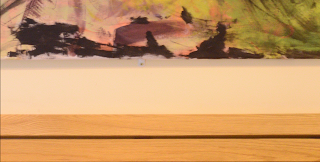50 mm : ISO 100 - f/16 - 3"
There seem to not have much of a difference between the noise reduction On and Off at ISO 100. Because the ISO is already very low, it doesn't change much to the image.
50mm : ISO 800 - f/16 - 0.4"
50mm : ISO 800 - f/16 - 0.4"
Off :
For 800 ISO, we start seeing a little bit of noise around when the noise reduction is Off, mostly on the canvas. When I turn my noise reduction On, I think that my camera reduces pretty well for a high ISO without loosing much details. Since noise is much more visible in darker places, I assured myself to at least have a little bit of black to compare my noise reductions properly.
50mm : ISO 6400 - f/16 - 1/20 secs.

For 800 ISO, we start seeing a little bit of noise around when the noise reduction is Off, mostly on the canvas. When I turn my noise reduction On, I think that my camera reduces pretty well for a high ISO without loosing much details. Since noise is much more visible in darker places, I assured myself to at least have a little bit of black to compare my noise reductions properly.
50mm : ISO 6400 - f/16 - 1/20 secs.
Off :
For 6400 ISO, which is the highest ISO possible on the Nikon D3200, if we compare it to the other ISO featured on this blog, we can see a pretty good difference, noise reduction on and off. Although for the noise reduction on, I still think it does a pretty decent job in reducing the noise. I only have an On & Off option for noise reduction so I can't do a comparison between Low, Standard & High but if I had to choose between keeping the noise reduction On & Off, I'd prefer keeping it On because I don't loose much details after all.

For 6400 ISO, which is the highest ISO possible on the Nikon D3200, if we compare it to the other ISO featured on this blog, we can see a pretty good difference, noise reduction on and off. Although for the noise reduction on, I still think it does a pretty decent job in reducing the noise. I only have an On & Off option for noise reduction so I can't do a comparison between Low, Standard & High but if I had to choose between keeping the noise reduction On & Off, I'd prefer keeping it On because I don't loose much details after all.







































